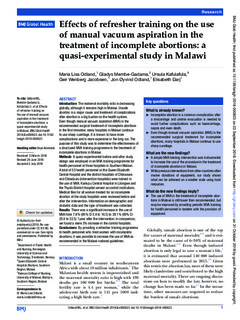| dc.contributor.author | Odland, Maria Lisa | |
| dc.contributor.author | Membe-Gadama, Gladys | |
| dc.contributor.author | Kafulafula, Ursula | |
| dc.contributor.author | Jacobsen, Geir W | |
| dc.contributor.author | Odland, Jon Øyvind | |
| dc.contributor.author | Darj, Elisabeth | |
| dc.date.accessioned | 2019-01-30T09:30:45Z | |
| dc.date.available | 2019-01-30T09:30:45Z | |
| dc.date.created | 2018-10-03T09:06:41Z | |
| dc.date.issued | 2018 | |
| dc.identifier.issn | 2059-7908 | |
| dc.identifier.uri | http://hdl.handle.net/11250/2583016 | |
| dc.description.abstract | Introduction The maternal mortality ratio is decreasing globally, although it remains high in Malawi. Unsafe abortion is a major cause and treatment of complications after abortion is a big burden on the health system. Even though manual vacuum aspiration (MVA) is the recommended surgical treatment of incomplete abortions in the first trimester, many hospitals in Malawi continue to use sharp curettage. It is known to have more complications and is more expensive in the long run. The purpose of this study was to determine the effectiveness of a structured MVA training programme in the treatment of incomplete abortions in Malawi.
Methods A quasi-experimental before-and-after study design was employed in an MVA training programme for health personnel at three hospitals in Southern Malawi. A total of 53 health personnel at the Queen Elizabeth Central Hospital and the district hospitals of Chikwawa and Chiradzulu (intervention hospitals) were trained in the use of MVA. Kamuzu Central Hospital in Lilongwe and the Thyolo District Hospital served as control institutions. Medical files for all women treated for an incomplete abortion at the study hospitals were reviewed before and after the intervention. Information on demographic and obstetric data and the type of treatment was collected.
Results There was a significant increase in the use of MVA from 7.8% (95% CI 5.8 to 10.3) to 29.1% (95% CI 25.9 to 32.5) 1 year after the intervention. In comparison, we found a mere 3% increase in the control hospitals.
Conclusions By providing a refresher training programme to health personnel who treat women with incomplete abortions, it was possible to increase the use of MVA as recommended in the Malawi national guidelines. | nb_NO |
| dc.language.iso | eng | nb_NO |
| dc.publisher | BMJ Publishing Group | nb_NO |
| dc.rights | Navngivelse-Ikkekommersiell 4.0 Internasjonal | * |
| dc.rights.uri | http://creativecommons.org/licenses/by-nc/4.0/deed.no | * |
| dc.title | Effects of refresher training on the use of manual vacuum aspiration in the treatment of incomplete abortions: a quasi-experimental study in Malawi. | nb_NO |
| dc.title.alternative | Effects of refresher training on the use of manual vacuum aspiration in the treatment of incomplete abortions: a quasi-experimental study in Malawi. | nb_NO |
| dc.type | Journal article | nb_NO |
| dc.type | Peer reviewed | nb_NO |
| dc.description.version | publishedVersion | nb_NO |
| dc.source.volume | 3 | nb_NO |
| dc.source.journal | BMJ Global Health | nb_NO |
| dc.identifier.doi | 10.1136/bmjgh-2018-000823 | |
| dc.identifier.cristin | 1617422 | |
| dc.description.localcode | © Author(s) (or their employer(s)) 2018. Re-use permitted under CC BY-NC. No commercial re-use. See rights and permissions. Published by BMJ. | nb_NO |
| cristin.unitcode | 194,65,20,0 | |
| cristin.unitname | Institutt for samfunnsmedisin og sykepleie | |
| cristin.ispublished | true | |
| cristin.fulltext | original | |
| cristin.qualitycode | 1 | |

